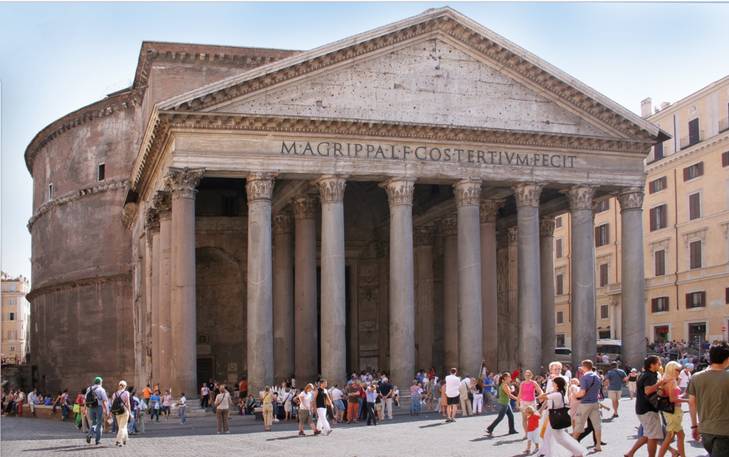


It is a hot topic these days in Rome: should visitors to the Pantheon, which attracts almost twice the visitors of the Colosseum and the Vatican Museums, pay an entry fee? Or should a visit be free of charge, as it has been for centuries? That Rome needs funds to maintain its treasures is obvious, but the answer is anything but simple. The fact that this, the most venerable and popular of all Roman monuments, is both pagan temple and Christian church complicates the issue.
The name derives from the Greek, "pan" meaning "every" and "theion" meaning "temple." It was constructed by the Emperor Hadrian around 126 AD upon the century-old ruins of another temple. In the center of its 142-foot dome of unreinforced concrete -- supposedly still the largest such structure in the world -- is a famous oculus, or hole, open to the sky.
In a letter to the editor to a Roman newspaper, Ursula Verena Fischer Pace, one of the many foreign residents who love the city, wrote this eloquent protest against paying entry into the Pantheon: "I came to Rome in 1968 and since 1973 have lived here permanently. For me the Pantheon has been a daily visit; to see it, enter inside and stand by the tomb of Raphael is to savour the very air of Rome. It has made me understand the grandeur of the city, its antiquity, its Christian heritage. I cannot believe that I can be expected to pay to go inside, to see its interior illuminated by a ray of sunlight [from the oculus] or see a sprinkle of rain. The Pantheon is not a 'museum' -- it is the heart of Rome. Should I have to pay a ticket to walk by the Trevi Fountain or climb the Spanish Steps?"
Interesting that Fischer Pace should specify the prospect of paying a ticket to climb the Spanish Steps. In fact, since no one is asked to do so, and the Steps were seriously damaged over time, a private sponsor, the jeweler Bulgari, has just forked out $2 million to have them repaired. Bulgari, understandably, remains concerned that after the reopening last September, the Steps may be damaged again very soon.
The fundamental problem is the incredible wealth of the Italian cultural heritage. That heritage is so rich, complex and detailed, illustrating layer upon precious layer of Western civilization, that its upkeep and restorations are as costly, difficult and technically demanding as they are necessary, and indeed ever more necessary.
As time passes, and the pressure of mass tourism and traffic pollution grow ever more intense, the situation worsens. This past week two youths jumping over the 12-foot tall entry gate at the Colosseum fell, and one was seriously injured. The next day a vandal painted a name and the word "Morte" (Death) in black on one of the exterior pilasters. The monuments of Rome -- all of them -- are at risk and require continual attention, including security surveillance. All this requires funding.
City hall Special Commissioner Francesco Paolo Tronca and Superintendent Claudio Parisi Presicce have listed 100 projects seeking sponsorships. One is Restoration of the Celio monuments atop that magnificent hill, expected to cost E24.2 million. Work on the cryptoportico of Trajan's Baths will require $23.5 million; the Torre Argentina temple area, $1.6 million; and the central archaeological area of the Forums of Caesar and Trajan, with removal of a section of the road Mussolini built between them, $3.2 million. Maintenance of Rome's 80 fountains will require another $11.1 million.
Besides Bulgari, other private sponsors have stepped forward. Azerbaijan has contributed to a restoration in the Capitoline Museums, and Unilever and the Italian utility works Acea funded new lighting for the Imperial Forums. Not only monuments require funding: there is also grand opera and the theater. The huge complex of the Auditorium Parco della Musica, where the famous Santa Cecilia orchestra performs, attracts 2 million visitors a year for 1,200 cultural and musical events and conferences. It is subsidized by the Rome Chamber of Commerce (35% this past year). in the meantime, ordinary maintenance of Rome -- roads, rubbish removal, public transport -- continues to be neglected. As a headline in La Repubblica daily put it, "Chaos for rubbish and transport: The quality of life in the Capital is in the pits."
Presuming that the 7 million annual visitors to the Pantheon contribute to maintenance of the monuments, this could only be a good thing, but among the politicians here opinions continue to be divided, and the Italian Catholic Church authorities have yet to speak on the question of funding or, for that matter, of security precautions.
"Paying a ticket would be right if it helps to save our treasures," said Corrado Augias, popular TV presenter and former member of the European Parliament. Against paying is the authoritative art historian Tomaso Montanari, for, "The dignity of the Pantheon is intimately bound to the heart of our identity."
A solution could be to require a very small payment, say of one Euro, for each visitor, the sums to be divided between church and state. Another, also suggested in letters to the editor, would be to begin with a test: suggesting voluntary contributions. It will be interesting to learn what i-italy readers have to say.
Source URL: http://newsite.iitaly.org/magazine/focus/op-eds/article/pantheon-pay-or-not-pay-question-0
Links
[1] http://newsite.iitaly.org/files/pantheontopayornottopaythatisthequestionpantheonjpg